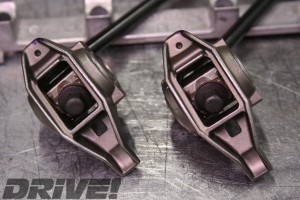Best of Both Worlds: World Products’ Motown LS Block Enables a Big Power Advantage With The Installation Ease of a Classic Chevy Small-Block
Text and Photos by Barry Kluczyk
Best Of Both Worlds: World Products’ Motown LS Block Enables a Big Power Advantage With The Installation Ease of a Classic Chevy Small-Block
LS engine swaps in muscle car-era vehicles are all the rage these days and there’s a very good reason: Those engines make crazy horsepower. The exceptional airflow characteristics of LS cylinder heads enable horsepower levels that most big-blocks weren’t capable of in the Sixties, but deliver it in a lighter-weight, small block-sized package.
What’s not to like, right? Well, the only problem with the swap is the swap itself. There are motor mount kits and accessory-drive kits for popular GM cars, like GM A-bodies, but fabrication is almost guaranteed for most swaps. That could mean chopping up an oil pan and/or the front cross member. It gets even worse if you plan to use air conditioning.
A best-of-both-worlds solution would be an engine that breathes and makes power like an LS, but bolts in place like a standard Chevy small-block. That’s possible with World Products’ (www.worldcastings.com) Motown LS cylinder block. The company redesigned the small block to match an LS engine’s water passages and accept LS cylinder heads.
It is unquestionably an out-of-the-box idea, but one that offer tremendous performance advantages.
“As much as the small-block and LS are different, there are some key similarities that make it work,” says World Products founder Bill Mitchell. “It’s clear when you examine the LS engine that there is a direct path back to the SB2 engine – an extension of the small-block design.”
Among the big enablers of this small-block/LS hybrid is one of the very details that GM instilled with the LS architecture: the small-block’s 4.400-inch bore centers. That means the heads’ combustion chambers are located perfectly above the bores. Also, an LS-style camshaft fits inside the small-block cam holes. All that’s needed is a distributor drive gear on the back of it and a fuel pump lobe on the front (COMP Cams makes them).
Surprisingly, what’s remarkable about building a Motown LS isn’t what’s new about the engine, but what is carried over from one engine or the other, including:
- A standard small-block crankshaft
- A standard small-block connecting rods
- A standard small-block distributor and timing gear
- Standard LS pistons (pinned to the SB rods without modification)
- Standard LS hydraulic roller lifters
- Standard LS valve springs and rocker arms.
Because World casts the Motown LS block with the standard LS deck height of 9.240 inches, off-the-shelf LS intake manifolds bolt on without a hitach. Of course, there are some unique pieces that make this combination work, and they include:
- The aforementioned camshaft with LS lobes, but small-block-specific fuel pump lobe and rear distributor drive gear
- Top-of-engine valley cover plate that mounts the top of the heads and the distributor
- Custom-length, 8.200-inch pushrods
- Adapter plates that bolt to the front of the heads for production-style accessories and water pump mounting.
Apart from the camshaft, World Products supplies all the other block-related parts.
The build-up
With the Motown LS block and related components collected, the assembly procedure is straightforward, with a few extras steps when compared to building a conventional Chevy small-block. Until about two years ago, World Products built crate-engine versions in-house, but they’ve since farmed out that work to a network of professionals across the country.
We recently followed the assembly of a carbureted Motown LS by Scott Feicht, of KMA Automotive Machine (305-872-1104), down in theFlorida Keys. It was designed as a street/strip engine, with a displacement was 427 cubic inches, which sounds like the perfect combo for a ’69 Camaro resto-mod. The goal was 600 naturally aspirate horsepower, which would eclipse the performance of the classic L-88 big-block, but in a small-block package – and an even lighter one than that, thanks to the aluminum LS heads. (The L-88 was officially underrated at 430 horsepower, but made more than 500.)
Building it as a 427, however, added a wrinkle to assembly equation: The Motown LS block is designed to accept the larger, 55mm cam size of an LS engine, but because of the large, 4.000-inch stroke, a smaller-diameter cam was needed for clearance, so Comp built a standard small-block-sized cam with LS lobe and small-block fuel pump lobe and distributor gear. As for the specs of the cam in our project engine, it delivers 0.650-inch lift on the intake side and 0.660-inch on the exhaust side, with duration of 250/255 degrees.
The heads used on the engine were World’s Warhawk LS-1 units. These cathedral-port, 15-degree heads have 235cc intake runners and flow very well out of the box, but they respond well to porting and World Products offers CNC-ported versions.
With the camshaft and heads in place, the rest of the engine combination falls together quite easily. The Motown LS block is designed to use LS lifters, which slip into the block small-block-style rather than the pocketed style of production LS engines. Because the camshaft is lower in the small-block than an LS engine, and the deck is significantly higher than a regular small-block, neither regular-length LS pushrods nor small-block pushrods fit the bill. The Motown LS uses 8.200-inch-long pushrods. Stock small-block length is about 7.800 inches, while stock LS pushrods are about 7.400 inches long.
Inside the block, LS-style dished pistons are matched with the Warhawk cylinder heads. They use production-type metric piston rings, which appear to work very well in the small-block, with minimal friction. The connecting rods and crankshaft are off-the-shelf small-block parts. The 6.125-inch-long rods don’t even require machining in order to be pinned to the LS pistons.
The remainder of the assembly process is pretty much like buttoning up a standard LS or small-block. A regular LS intake manifold bolts right up and the small-block distributor simply drops through the valley cover. The spark plug wires are not conventional, however. Because of the differences in spark plug locations between LS and small-block heads, standard small-block wires don’t quite fit. And, of course, the distributorless LS ignition system uses only the shortest of leads between the coil pack and plug, so cut-to-fit universal wires are required.
The Motown LS uses the LS-style firing order of 1-8-7-2-6-5-4-3.
On the dyno
After buttoning up our project engine, it was wheeled into KMA Automotive’s dyno for testing – and it didn’t disappoint. After a brief warm-up/break-in period, the engine blasted past our 600-horsepower goal on the first try, with an eye-opening 631 horsepower and 580 lb.-ft. of torque. That wasn’t simply 31 horsepower more than we’d hoped for, but about 70 horsepower more than one of World’s conventional small-block 427 engines and about 15 horses more than their typical Warhawk LS combos.
We were understandably impressed with the results. The significant 70-horsepower premium over a comparable yet conventional small-block combo proves the LS design is head and shoulders above the small-block head design when it comes to airflow. Bill Mitchell notes the combination pays dividends beyond the obvious airflow advantage.
“When we built the first couple of Motown LS engines, we were surprised when they made noticeably more power than even our Warhawk LS engines,” he says. “They should have been about the same, but then we figured out the small-block, which doesn’t have the LS engine’s long-skirt cylinder block, had much better crankcase windage attributes. That seemed to make all the difference.”
And while the horsepower results were terrific, let’s not neglect the torque curve. The engine made 500 lb.-ft. at 3,500 and never dipped below that mark through 6,200 rpm. That’s a lot of grunt for an engine that take up no more space under the hood than a trusty 350.
One more thing…
As we wrapped our project, we got wind of a similar Motown LS combination put together by Reids Automotive, in Whitman, Mass.(www.reidsautomotive.com). They used CNC-ported cathedral-port heads on the same 427-inch displacement/single four-barrel configuration and cranked out 665 horsepower and more than 600 lb.-ft. of torque.
The implications for the Motown LS are far-reaching, particularly for racers who are required to run a distributor. As for street enthusiasts, it is performance that was just about unattainable in a naturally aspirated small-block previously. In fact, it offers big-block performance without the weight penalty and LS power without the installation hassles.
That’s not just the best of two worlds. It’s the best of all worlds.
KMA Automotive Machine
Big Pine Key,Fla.
305-872-1104
Email: kmaenterprise@gmail.com
World Products
Ronkonkoma,N.Y.
631-981-1918
www.worldcastings.com
The first piece of the Motown LS puzzle is World Products’ redesigned cylinder block, which adapts LS heads via the water passages and bolt pattern. The decks are raised to the LS-production spec of 9.240 inches, so any LS intake will bolt right up.
The Motown II LS block in the foreground is clearly differentiated from the conventional small-block (at rear). Both, however, are based on World’s redesigned block casting that uses an updated oiling circuit.
This close-up shot illustrates the water passage and head bolt designs that were transferred to the small-block architecture. It uses four head bolts per cylinder, like a production LS engine. The redesigned water passage was a big deal, because the small-block feeds coolant into the block first, while the LS pushes it through the heads first.
The block also incorporates the oiling system revisions of World’s “regular” Motown II block, meaning the oil restrictors are moved from the rear of the block to valley for easier access. The cam journal oil holes also are relocated to ensure adequate flow with a high spring pressure.
Here’s one of the oil restrictors being installed in its new position in the valley, which makes removal much easier when the engine is in a vehicle.
A standard small-block crankshaft is used without modification. In the case of this first Motown LS build-up, it’s a 4.00-inch stroker that will complement 4.125-inch bores to deliver a 427-cubic-inch displacement.
Another standard small-block item is the oil pan; same goes for the motor mount locations. Those features enable cheap, hassle-free installation in an older vehicle or racecar originally designed for a small-block.
The Motown LS requires a custom camshaft – a hybrid of an LS hydraulic roller design that will work in the small-block cylinder block and actuate the LS valvetrain. The system also uses production-style LS roller lifters. Here, a standard LS cam (top) is shown with the custom stick from Comp Cams. Note the redesigned rear end, where the distributor drive gear is grafted. At the front is a fuel pump lobe.
The cam used in our test engine had a standard small-block diameter, not the larger, 55mm size of the production LS cam – but the Motown II/Motown II LS blocks can accommodate a 55mm cam. Lift and duration specs are 0.650/0.660-inch and 250/255 degrees, respectively.
Off-the-shelf forged aluminum LS pistons for the 4.125-inch bores are used with LS-type metric rings. There’s nothing trick about them – just more off-the-shelf parts for this unique engine. Compression is a streetable 10.7:1. Standard small-block-sized connecting rods are used. Not even the small end has to be machined for the LS pistons, as the pin diameter is the same.
Here are the LS lifters being inserted into the block small-block-style, rather than the pocketed design of an LS engine. The block was designed for the LS lifters – they wouldn’t work on a standard small-block.
This unique valley cover plate is key to the Motown LS. It secures the upper portion of the heads and because an LS-type spider intake is used, provides a mounting location for the distributor. Also: the valley cover has a removable top section that allows easy access to the lifters, and to the oil restrictors as well.
Here’s World’s Warhawk LS-1 heads being installed on the small-block. The raised deck of the cylinder block puts the heads in the same position as a stock LS engine, for intake manifold compatibility.
Any production LS cylinder head will work , but the project engine uses World’s Warhawk cathedral-port, 15-degree head. It features large, 235cc intake runners and flow about 313 cfm out of the box (at 0.700-inch lift and 28 inches of water) and about 345 cfm when ported.
Production LS valvetrain components, including the rocker arms, springs, etc. are used, but the combination requires custom 8.200-inch pushrods because of the non-LS camshaft position.
Here’s the long-block assembly of the Motown LS. Note how the custom valley plate cover fits like the final piece of a mechanical puzzle. The engineering to bring the engine to this point is, frankly, amazing.
The other unique parts created for the Motown LS include adapter plates for the front of the heads to mount a water exit path and other accessories. The block uses a small-block water pump, sending water into the block, up through the heads and out the adapter plates through hoses connecting to a remote thermostat housing, which connects to an upper radiator hose to the radiator inlet.
Because the Motown LS has an LS-production deck height, a standard LS intake bolts up without a problem. In this case, it’s an Edelbrock intake capped with a velocity-enhancing spacer and an AED-built 1050 Dominator.
Just like a regular small-block, the distributor slips in at the rear. The only problem is plug wires. Standard small-block wires don’t fit quite right, so a cut-to-fit kit is necessary. On this engine an electronic MSD distributor provides the spark.
Here’s the finished project engine. Although it wears a carburetor and was built has a street/strip engine, a fuel injection manifold would work, too, as long as there’s room at the rear for the distributor. the engine would just as easily accept a factory-style fuel injection system. The need for custom headers is the biggest installation issue, although some of the LS swap headers for popular vehicles may work.
Without any real tuning and 36 degrees of total timing, our Motown LS engine cranked out 631 hp and 580 lb.-ft. on the first try. World Products has experimented with other similar combinations and extracted 650 horsepower out of them, along with just about 600 lb.-ft. That’s a helluva powerful small-block.
DYNO TEST
Engine: World Products Motown LS
Displacement: 427 cubic inches
Camshaft: Comp Cams hydraulic roller
Camlift: 0.650-inch (intake) / 0.660-inch (exhaust)
Carburetor: 1050 cfm
Intake: Edelbrock Victor Jr LS
Rocker arm ratio: 1.7:1
Timing: 36 degrees
RPM HORSEPOWER* TORQUE*
3500 333 500
3600 347 507
3700 357 507
3800 366 507
3900 375 506
4000 386 507
4100 397 509
4200 410 513
4300 425 520
4400 443 529
4500 463 540
4600 481 550
4700 500 559
4800 517 566
4900 534 575
5000 549 579
5100 562 580
5200 571 578
5300 575 570
5400 575 559
5500 577 551
5600 586 548
5700 597 548
5800 609 548
5900 619 546
6000 625 543
6100 628 538
6200 631 533
*peak numbers in bold
FORCE-FEEDING THE MOTOWN LS
As we mentioned in the main story, the Motown LS enables the small-block to benefit from the exceptional airflow characteristics of LS cylinder heads. Those attributes are amplified considerably when a supercharger is added to the mix. That’s exactly whatUtah’s Thunder Custom Auto did. In fact, they’ve taken the basic Motown LS recipe and tweaked it to add even more LS content to it, including eliminating the distributor for a crank-triggered ignition, with LS-type individual ignition coils. The engine is also fuel injected, with engine management chores handled by a F.A.S.T. XFI controller.
The supercharger is 2.3-liter unit from Magnuson, featuring Eaton’s four-lobe TVS rotors (the same as used on the Corvette ZR1’s LS9 engine). It uses 83-lb. fuel injectors and draws air through a F.A.S.T. 92mm cable-operated throttle body. The accessory drive system includes air conditioning, as the engine is destined for a unique Dually pickup street hauler that will be stalking the long highways ofWyoming. It sounds like it will be a helluva fun truck!
“We believe this is the first supercharged Motown LS engine ever built and we’re very happy with the results,” said Steve Martinson, of Thunder Custom Auto. “It’s a great combination.”
Thunder Custom Auto is on the Web at www.thundercustomauto.com.


























